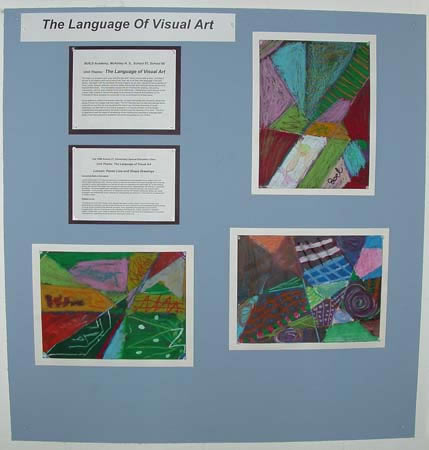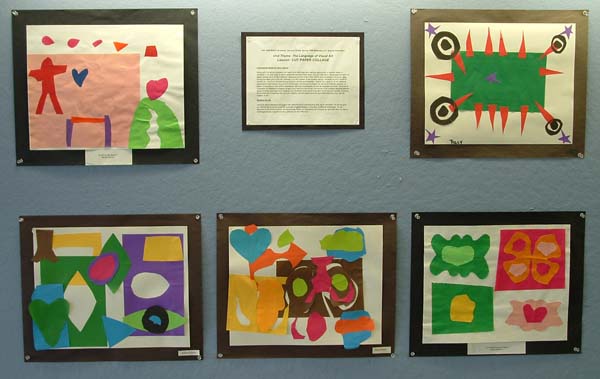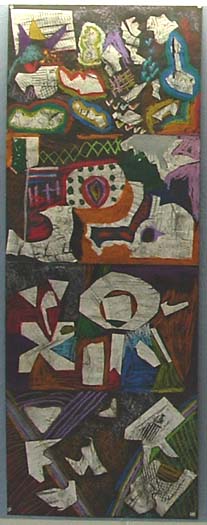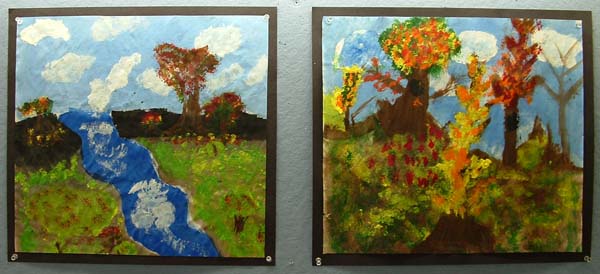Unit Theme: The Language of Visual Art
Author: Lucy Andrus
We begin our program each year with the idea that "every picture tells a story" and that if we are to be makers and consumers of art, then we must learn the language of art and artists. We begin with the alphabet of visual imagery as we learn about formal properties of lines, colors, shapes, textures, and how artists manipulate and compose these elements to express their ideas. This foundation equips the Art Partners for viewing, discussing, interpreting, valuing, and creating works of art effectively. Developing visual literacy in this manner also relates to life and the ability to successfully interpret and respond to the multitude of visual symbols we encounter in our environment on a daily basis.
1. Pastel Line and Shape Drawings
Fall 2000 School 57, Elementary Special Education Class
Lesson 1: Pastel Line and Shape Drawings

Conceptual Basis of the Lesson
Laying the foundation for visual art expression includes teaching the alphabet of line, shape, color and texture (basic elements of art). Helping children to become articulate in this visual language maximizes the potential for artistic self-expression as well as the ability to understand and appreciate art. In this drawing activity, the children began with the basic art element of line, experimenting with direction, movement and space. Resulting shapes were highlighted, colors were mixed and blended, and textures were discovered. In the process, abstraction is introduced, and the Art Partners realize that artists can create successful and aesthetically worthy artworks by manipulating the elements in ways that are not dependent on subject matter.
Relation to Life
The elements of art (line, shape, color, texture) are seen in every object in our environment, and developing our abilities to perceive them enhances our skill in perceiving and comprehending the variety of visual symbol systems that pervade our world, from negotiating the physical environment to navigating the Internet. Awareness of the principles of art (balance, rhythm, symmetry, repetition, pattern, organization, etc.) helps to develop the kinds of skills that allow us to make sense of incoming information by organizing visual stimuli into meaningful constructs.
Fall 1996 BUILD Academy, Second Grade;
Spring 1999 McKinley H.S. Special Education
Lesson 2: Cut Paper Collage

Conceptual Basis of the Lesson
Along with the second graders, our teens from McKinley also had the opportunity to explore ideas of narrative in art and ways in which artists tell stories in their work. For our inspiration, we studied the later cut paper collage work of Henri Matisse developed by the artist in the 1940's and published in his book, Jazz.
During the latter part of his life, Matisse, a prolific master of the modern art era, became too ill to handle a paintbrush. He found himself facing physical infirmity and disability. Rather than give up his art, Matisse developed a new means to give form to his inner visions and he began his series of brilliantly painted cut paper compositions with artistic expression serving a therapeutic as well as aesthetic purpose. Sources of inspiration for Matisse's collages ranged from nature to the circus, and some of his collages became stained glass windows and large wall hangings. Our students found inspiration from various sources, including the excitement of working with their own brightly colored papers and the discovery that they, too, can be makers of art.
Relation to Life
Learning about Matisse’s struggles with disability and understanding that as an artmaker he did not give up, offered the students a real life example of perseverance in the face of difficult challenges. As we discover in the Art Partners program when we discuss the Three A’s, artmakers do not give up, and they learn to view a challenge not as a barrier but as a pathway to new learning!
Fall 1995 BUILD Academy, Second Grade Inclusion Class
Lesson 3: Texture Rubbing Panel
Conceptual Basis of the Lesson
This activity was designed to help the children learn more about the basic art element of texture and the tactile qualities of an artwork. Sharpening visual perception of textural qualities in a two-dimensional artwork can be a challenge requiring an approach that offers students an initial concrete experience with the concepts to be learned. Following actual tactile exploration of three-dimensional objects, the children were sent off to find textures in their environment and to ‘make a picture’ of these using a rubbing technique with black pastel and white paper. The textured shapes were then cut out and collaged onto black paper, and negative space was highlighted with the addition of colored oil pastels. The children combined their individual compositions to make larger panels, one of which is displayed here.
Relation to Life
Developing sensory intelligence sharpens perceptual skills and concept formation, all aspects of enhancing cognitive functioning. Paying particular attention to sensory qualities such as texture helps lay the foundation for developing aesthetic sensibilities as well as also deepening children’s understanding and appreciation for the things in their environment.

Fall 1995 BUILD Academy, Second Grade Inclusion Class
Lesson 4: Group Paintings Inspired by the Abstract Expressionists

Conceptual Basis of the Lesson
Our trip to the Albright-Knox Art Gallery included a look at abstract expressionism, a uniquely American style of painting that evolved in the late 1940s in New York City with artist, Jackson Pollack, in the forefront. With the advent of abstract expressionism, New York City became a major international art center the likes of which had made Paris so attractive since the start of the modern art movement. When viewing the large paintings by Pollack, one can almost feel the energy and emotion spontaneously expressed by the artist as he dripped, poured, danced and moved paint around on large, unstretched canvases on the floor. Along with Pollack, works by Lee Krasner (who was married to Pollack), Helen Frankenthaler and Robert Motherwell provided inspiration for our abstract expressionist murals. The Art Partners worked subjectively, spontaneously applying paint according to inner emotional sensations. Painting in small groups together on the same sheet of mural paper allowed the Art Partners an opportunity to manage feelings towards each other while promoting a sense of sharing and community
Relation to Life
Painting in an emotionally spontaneous manner offers students a valuable opportunity to express themselves in a socially acceptable way. Creating these paintings in small groups affords each student the chance to practice socialization skills as space, time and materials are shared.
Spring 2000 School 57, Elementary Special Education Class
Lesson 5: Impressionist Landscapes

Conceptual Basis of the Lesson
During a unit on European culture, a stop in France to "visit" the gardens of Giverny seemed especially in order this year, thanks to the wonderful Monet exhibit at the Albright-Knox Art Gallery. Our student teachers presented a lesson on the impressionist style of Claude Monet and exposed the children to a whole new way of seeing and painting.
While it was not possible for us to paint en pleine air ("in the open air") as the impressionist artists had, viewing and discussing pictures of Monet's paintings allowed us to conjure up outdoor scenes in our imaginations. The Art Partners painted their scenes using non-traditional tools such as sponge bits and cotton swabs.
Relation to Life
The Impressionist painters were essentially asking us to see and appreciate the world in a whole new way when they presented their new style of painting to the world. The ability to perceive our environment and the people and things in it through multiple lenses is a critical living skill for the 21st century, and calls for a similar ability to be open to other viewpoints. Many Impressionist works also encourage us to respond to our natural world with greater appreciation by heightening aesthetic sensitivity and evoking greater empathy and care for our environment in the process.
Fall 1998 BUILD Academy;
Fall 2000 School 57, Elementary Special Education Class
Lesson 6: Mixed Media Still Life

Conceptual Basis of the Lesson
Having acquired a foundation in the basic art elements and principles, the children were now ready to apply this understanding to a more sophisticated form of visual expression. The choice of still life as subject matter fit our second and fourth grade children's emerging developmental concerns to try and make things "look right", while the choice of mixed media addressed their need to explore, experiment, and develop competence with materials and methods. The tasks involved in creating
our still lifes took place over a three week period, beginning with exercising our visual perception in being able to break down an object and see the basic lines and shapes it is composed of in order to draw it more accurately. We then studied the still life works of Henri Matisse, Paul Cézanne and Ethelyn Stewart; artists who helped us to understand such ideas as composition, use of space, balance, pattern, and the beauty in every day objects. The children were excited to discover that they could, indeed, draw and render an object realistically if they were willing to see that object "with the eye of an artist".
Relation to Life
In addition to the benefits of developing visual literacy cited previously, exploring still life as artistic subject matter sharpens awareness of our immediate surroundings. In this process of encouraging attention to
everyday life in a way that elevates the mundane, children develop aesthetic sensibilities that are applicable to quality of life issues.
This is a non-commercial website and is to be used for educational or research purposes only. No commercial use is permitted without the consent of Art Partners. "Fair use" is claimed under U.S. copyright law, sections 107 and 108. For questions contact:Art Partners
©2002 Art Partners Program | All Rights Reserved